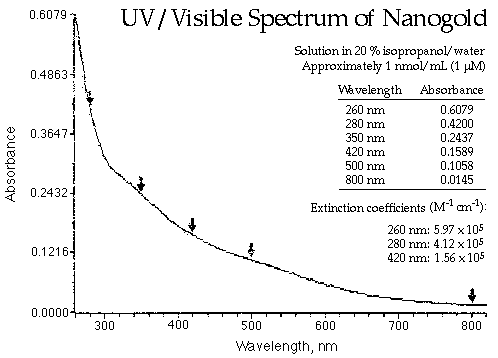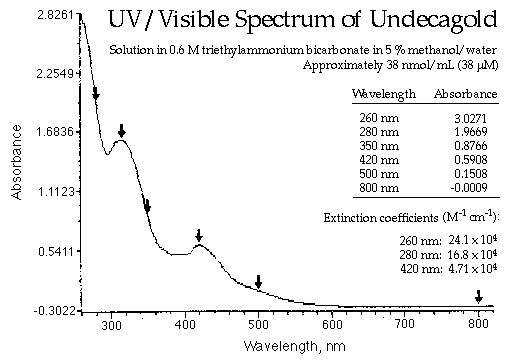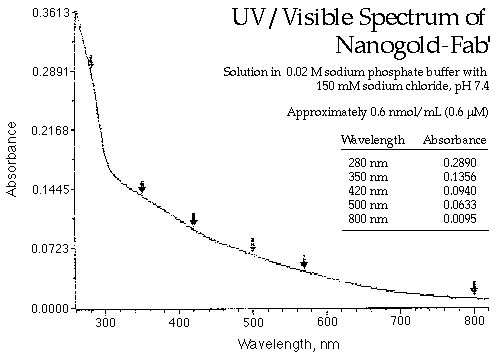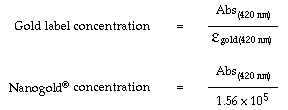|
|
Labeling with Gold Nanoparticles:
Spectra and Labeling Calculations
Once you have isolated your gold nanoparticle conjugate, the extent of labeling (the number of gold nanoparticles per biomolecule) can be calculated using the UV/visible spectra of the nanoparticle and the conjugate.
- For proteins with no absorption in the visible region, use our Simple Method as described below. Labeling may be calculated directly using UV/visible spectrum of the conjugate.
- For proteins with significant visible absorption, use our Advanced Method, based on simultaneous equations.
Background Information:
Calculation of labeling with gold nanoparticles: Simple Method


The extinction coefficients for these nanoparticles at 420 nm have been accurately determined (and those for other values can be estimated from the spectra), and these, together with representative values at 280 nm abd the values at 260 nm, are shown on the spectra. Most proteins absorb strongly at 280 nm, but have no absorbance at 420 nm. Therefore, in the conjugate spectrum, while any absorbance at 420 nm must come from the gold nanoparticle, the absorbance at 280 nm contains a contribution from the Nanogold and an absorbance due to the conjugate protein.
Absorbance at 260 nm is used to quantitate oligonucleotides, and therefore the extinction coefficients at 260 nm (where oligonucleotides absorb most strongly) and 420 nm are used to calculate oligonucleotide labeling. you can claculate the extinction coefficient for an oligonucleotide of known sequence by adding the extinction coefficients for its individua bases.
Reference:
The UV/visible spectrum of a typical Nanogold®-Fab' conjugate is shown below:

Below are a STEM micrograph and a TEM micrograph showing Nanogold® these show the types of images which may be obtained with this reagent. Complete instructions on microscope adjustment for best viewing are given in the Instructions for Nanogold®-antibody conjugates.
![[Nanogold-Fab' STEM micrograph] (33k)](../Images/NGFab.gif)
|
![[EM Nanogold-RBCs] (29k)](../Images/NGRBC.gif)
|
|
Dark field electron micrograph of Nanogold®-Fab'. Each 1.4 nm Nanogold® particle (white dot, small arrow) is covalently attached to an Fab' antibody fragment (light gray, large arrow) and chromatographically purified. No aggregates of gold or protein are formed in this new technological breakthrough in gold immunoprobes. Original magnification = 3,000,000Xa.
|
Fab'-Nanogold® is shown here labeling blood type antigens on the membrane surface of the human red blood cell (RBC). After thorough washing, the cells were fixed and embedded in Lowicryl and thin sectioned. 80 nm section showing individual unenhanced 1.4 nm Nanogold® particles (arrow). No other stains were used.
|
|
Micrographs reprinted with permission of the San Francisco Press. |
In the spectrum of the Nanogold® or undecagold nanoparticle, the ratio of absorbance at 280 nm to absorbance at 420 nm is always the same. Therefore, the absorbance at 420 nm can be used to calculate the portion of the absorbance at 280 nm which is due to the Nanogold®. The remainder of the 280 nm absorbance therefore arises from the conjugate, as shown below:

The optical density at 280 nm is known for many proteins, and can be converted to the extinction coefficient:

Values for the extinction coefficients of Nanogold® and undecagold, and for IgG and Fab' at 280 nm and 420 nm are shown below:

Most proteins do not absorb at all in the visible spectrum: therefore, the absorbtion at 420 nm arises solely from the Nanogold®. First, the measured absorption at 420 nm, and the extinction coefficient of Nanogold® at 420 nm, are used to calculate the amount of gold in the solution:

Next, the measured absorption at 420 nm is multiplied by the ratio of the extinction coefficient of Nanogold® at 280 nm to its extinction coefficient at 420nm. This gives the absorption at 280 nm that is due to Nanogold®. This is then subtracted from the measured absorption at 280 nm to give the absorption at 280 nm that is due to the protein:

This value for the absorbance due to protein at 280 nm and the extinction coefficient of the protein at 280 nm are then used to calculate the protein concentration:

Note: The actual value for the extinction coefficient of Nanogold at 280 nm varies slightly from lot to lot. The most accurate value for the lot you are using will be given in the product specification sheet supplied with your product: use this value for the most accurate labeling calculation.
The labeling efficiency is the concentration of Nanogold® divided by the concentration of protein.

Note: For systems where the protein or biomolecule has significant absorbance in the visible range, the labeling calculation is more complex, and is based on the solution of a pair of simultaneous equations which describe the absorbance at two wavelengths. This method is given in full on a separate page:
Advanced Method of Labeling Calculation
for proteins with significant absorption in the visible range
References
- Hainfeld, J.F. and Furuya, F.R. A 1.4nm Gold cluster covalently attached to antibodies improves immunolabeling, J. Histochem. Cytochem., 40, 177-184 (1992).
- Gregori, L., Hainfeld, J. F., Simon, M. N., and Goldgaber, D. Binding of amyloid beta protein to the 20S proteasome. J. Biol. Chem., 272, 58-62 (1997).
- Takizawa, T. and Robinson, J.M. Use of 1.4-nm immunogold particles for immunocytochemistry on ultra-thin cryo-sections. J. Histochem. Cytochem., 42, 1615-1623 (1994).
Further references
|